Ficus robusta: features, tips for choosing and care
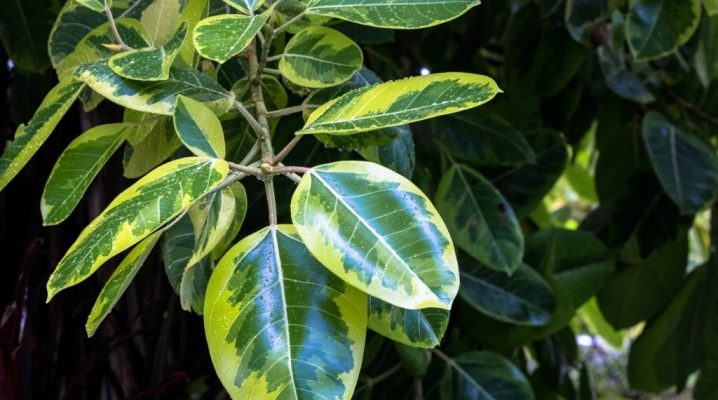
The rubber ficus robusta is commonly used to create natural rubber, but many gardeners prefer to grow it for purely decorative purposes. He is not capricious and looks very dignified. It is also convenient that the height of most "home" specimens does not exceed 60 centimeters.

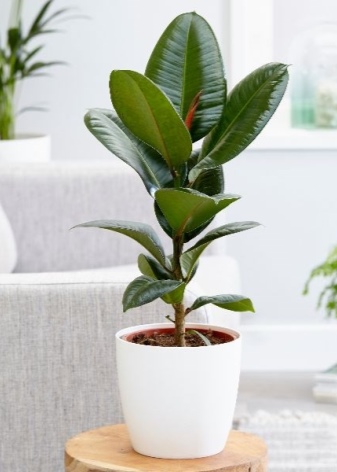
Features and characteristics
The rubber-bearing ficus robusta is a tall tree belonging to the mulberry genus. The homeland of the plant is Indonesia and China, but in nature it is also found in Nepal, China and India. Robusta is the tallest of the ficuses: some of its representatives reach heights exceeding 60 meters. The diameter of the trunk can be several meters, and in room conditions, being much smaller, it can branch out significantly. The crown of the ficus does not expand with age, but the roots can overtake the soil by growing.
Elastica differs from its "relatives" in leaves - wide, wavy and shiny. The width of one leaf can exceed 20 centimeters, and the length can reach 40 centimeters. However, most often the length is in the range from 20 to 25 centimeters, and the width is 15 centimeters. Young plates sometimes form a kind of envelopes, which then fly around.
The edge of the leaf looks inward. If you touch it, you will get the feeling of a waxy coating.
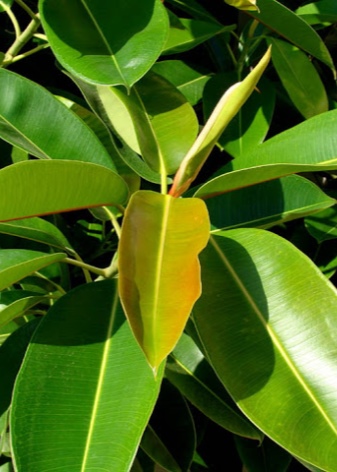
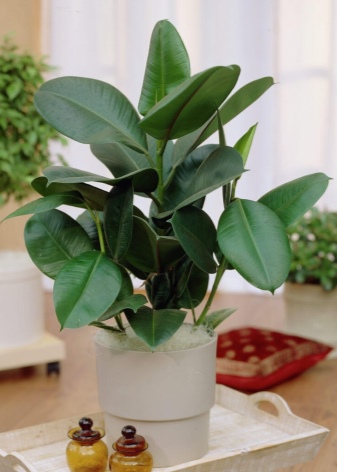
Ficus parts change their color over time from red-green to pure emerald. The leaflet description also contains information that the shape of the plate is rounded, reminiscent of an oval, but with a sharp tip pointing down. Finally, the leaf has a distinct red or green vein in the center and a short pale petiole. On a green trunk, the leaves are arranged sequentially along its entire length.
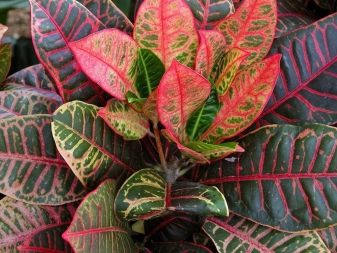

How to choose?
It is better to postpone the purchase of ficus for the spring or summer months - that is, the time of active growth of the plant. If the purchase takes place in the winter, then you should be prepared for the fact that the ficus will not be able to adapt to the new atmosphere. This is especially true for a novice gardener who is not able to immediately provide the required levels of humidity and temperature, as well as to establish a care system. Choosing a Robusta in a store, you will definitely have to carefully examine it. If the leaves, stems or roots that are visible through the drainage holes show incomprehensible spots or traces of damage, then the purchase should not be made.
It is right to choose fresh bushes that have recently been brought to shops that have not stood there for too long. It is worth shaking the ficus - if many leaves leave it, then you should not take such a plant. Perfectly not a single sheet should fly off. An alternative to shaking is to stroke the plant against the leaves. In addition to general inspection, Robusta should also be checked for mealybugs. Taking the ficus home, it must be carefully packed so as not to freeze.

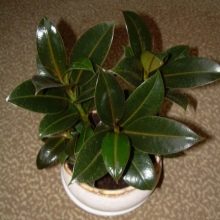
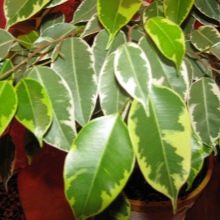
Experts advise against taking large mature specimens. The fact is that the older the plant, the more difficult it will be for it to adapt to the new environment. The roots of a healthy plant should not be black or dark brown. It is worth mentioning that often in stores, ficus leaves are rubbed with polish to achieve a beautiful shine that attracts customers.
When you get home, the solution must be washed off, since its chemical composition clogs the surface mouths and interferes with the provision of normal gas exchange.

How to care?
Caring for ficus robusta at home is especially important immediately after purchase. The fact is that the transfer of a plant to a different atmosphere, a different microclimate is a stressful situation. Therefore, for the time of adaptation, the ficus will have to be kept separate from other plants in a room with good lighting, but where direct streams of light do not fall, and also observe the watering regime. In general, Robusta feels good even on the windowsills of windows facing north, so it can be placed in a shaded place next to the loggia or windows.
Ficus robusta should not be planted next to the battery, since exposure to hot air leads to an acceleration of evaporation processes, which means that the bush may well get burned. In the off-season, that is, in autumn and spring, it would be good to move the plant to the loggia. In summer, if possible, it is even allowed to take it outside in case of sufficient exposure to sunlight.
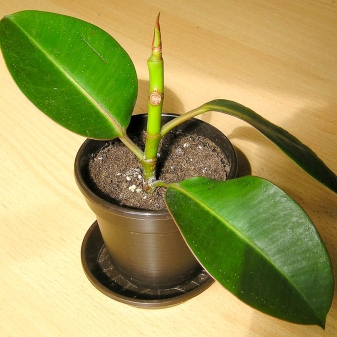

As for the temperature, then the bush feels good in the range from 18 to 25 degrees Celsius, that is, at normal room temperature. Smaller or larger degrees already negatively affect the development of culture, for example, leaves begin to fall off. If we compare the flowering of domestic ficus with what happens in the wild, we can say that it passes almost imperceptibly.
The sizes of both fruits and flowers of a beautiful green hue do not even reach 1 centimeter. Humidity must reach at least 50%... If in winter such an indicator cannot be obtained naturally, then it is worth either introducing regular spraying, or installing a humidifier in the room.
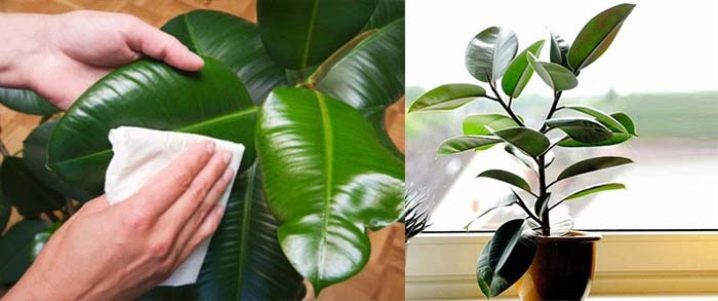
Top dressing
Ficus robusta prefers a soil mixture filled with useful elements: minerals and salts. Experts recommend purchasing ready-made soil in the store, making sure that it has good air permeability. Plant the bush correctly in a fairly large pot, and then transplant in addition every year. It is more convenient to take ready-made complex solutions as fertilizers that have a large amount of nitrogen in their composition. By the way, mature ficuses are almost impossible to transplant, so they just regularly change the top layer of the soil mixture.
Most of the fertilizer for the ficus is applied while it is actively growing, that is, from the beginning of spring to the end of autumn. At this time, feeding is planned every 2 weeks. Experts recommend giving preference to such proven formulations as "Ideal", "Gumisol" and "Palma". It is not forbidden to carry out foliar dressing.
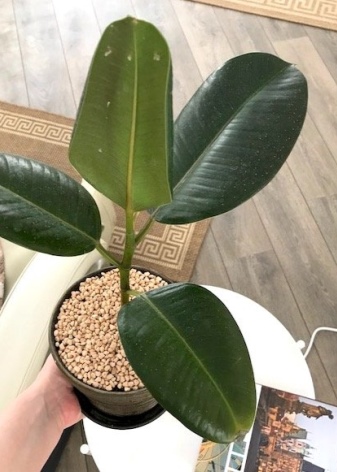
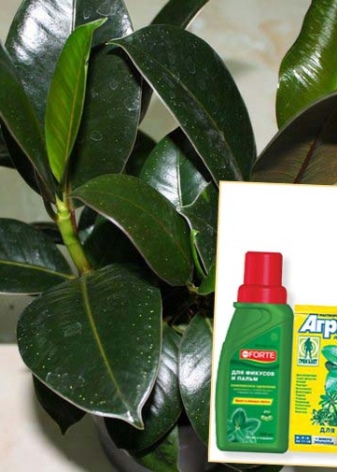
Watering
It is important to irrigate ficus robusta regularly and in large quantities. Of course, it is categorically not recommended to fill it in - excess liquid leads to decay of the root system, as well as an increase in the acidity of the soil. It will be possible to prevent trouble by organizing a drainage system, for the manufacture of which you will need either a composite or pebble stones. It is important to let the soil dry out before watering again.
In principle, a good solution would be to drain the remaining water from the sump after the ficus has absorbed the amount of moisture it needs. This preventive measure will help protect the bush from mold. In the warm season, it is customary to water the ficus every 3 days, and in the cold season it will be enough once every 5 days.
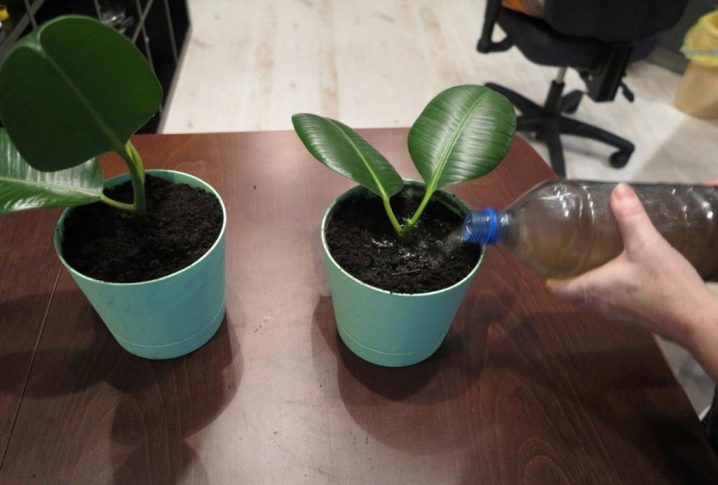
Fight disease
Ficus robusta is more susceptible to disease than pests. Sometimes spider mites are found on large leaves, but getting rid of them does not require special measures - it is enough to rinse the bush with cold water without touching the soil, and then wipe the leaves on both sides with moistened napkins. As for diseases, their main causes are improper crop care or some kind of stressful situation, for example, a transplant. As a result, ficus leaves fall off or change color, and the stem slows down its development. By the way, the disease may be "delayed" - its symptoms will appear only after a few months.
Falling or yellowing leaves can signal the presence of a draft or insufficient irrigation. Brown specks on the leaves occur due to excessive watering. For the same reason, rotting of the root system, accompanied by an unpleasant odor, also manifests itself. When Robusta drops the leaves very abruptly, at a time, this indicates that the state of the plant is critical, immediate intervention is required. Sometimes crown shedding occurs due to very dry air.


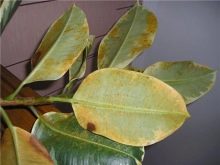
Pruning
There is no need for a gardener to form a crown of a ficus robusta. At home, it is customary for the plant to be given the opportunity to grow in the same way as it would happen in nature. If the lateral stems do not develop well, then you can cut off the top of the bush to stimulate them. If the desire to create an unusual crown is still present, then it is better to do it at the junction of February and March, when the ficus is preparing for active growth. The basic rule for crown formation is to trim 7 centimeters higher than required.
Thin stems are cut at right angles, and the trunk will have to be cut diagonally. You should be more careful with the main shoot, because its shortening will lead to the cessation of the development of the trunk of the bush. A knife or other used tool must be treated with fire or alcohol tincture. Besides, it is important to rinse it with a damp sponge at the end of the procedure, as robusta secretes a poisonous juice that is dangerous for the skin and mucous membranes of the human body. A less traumatic way of forming a crown is considered to bend and fix the apex or piercing new shoots to a certain depth.
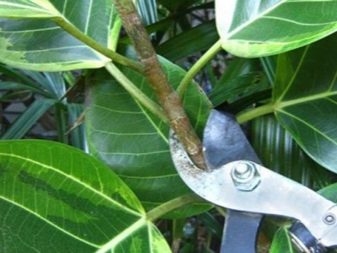
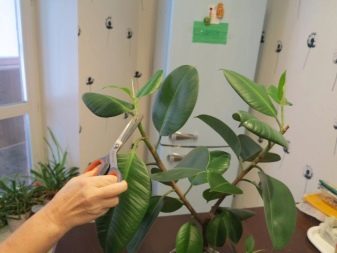
How to reproduce?
It is customary to propagate the plant using cuttings, which are formed, as a rule, from the stems left after the formation of the crown. For this purpose, be sure to take those parts of the ficus on which at least 3 leaves have already grown. Before planting the cutting in a pot, it will have to stand for a sufficient time in water until the release of poisonous juice stops. Next, the liquid is drained and replaced with a new one, enriched with a growth stimulant. The stalk remains in it until the roots appear. Once in fertile soil, the offshoot will be forced to "live" in the greenhouse.
This item is either purchased from a specialty store, or it is created from scrap materials, such as cut plastic bottles, glass jars, or other material that can transmit light rays.
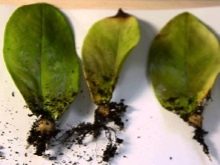

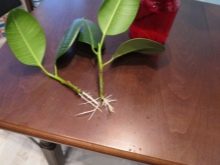
Important! Ficus robusta can also be propagated by seeds, layering of two types and leaf shoots.
For information on the features of robusta ficuses, see below.































The comment was sent successfully.